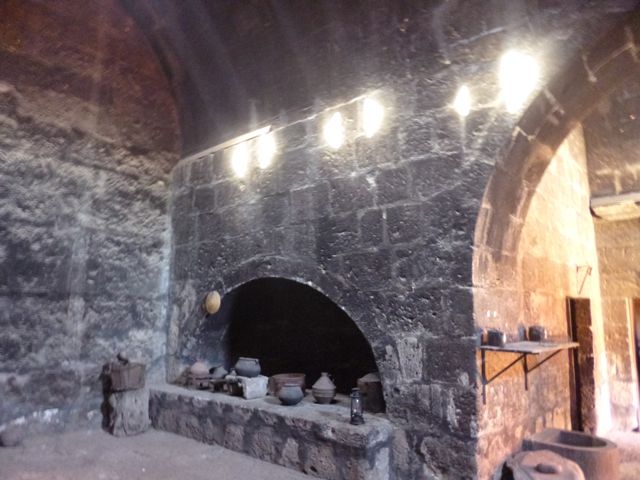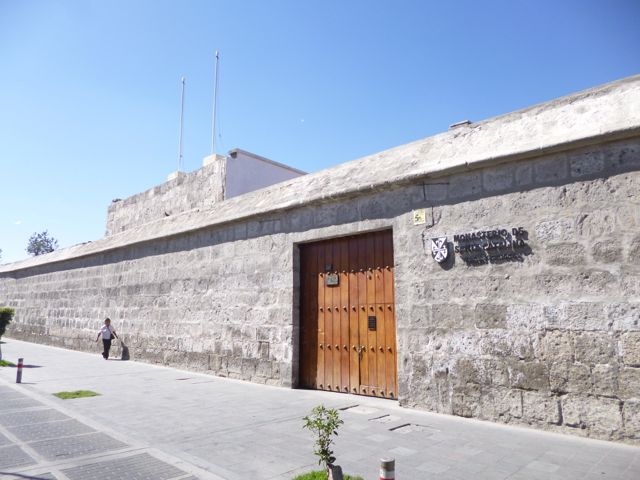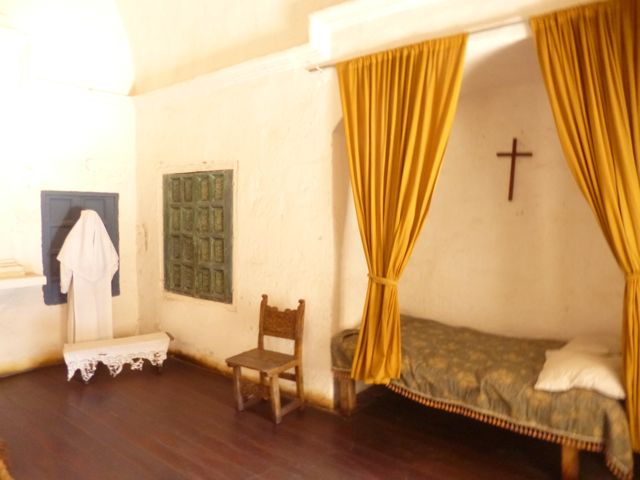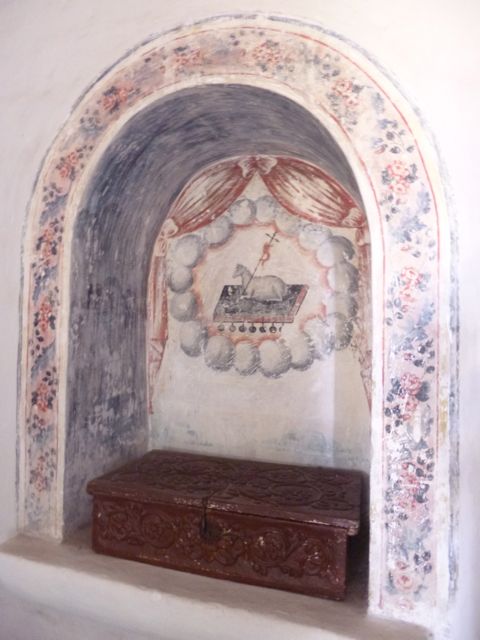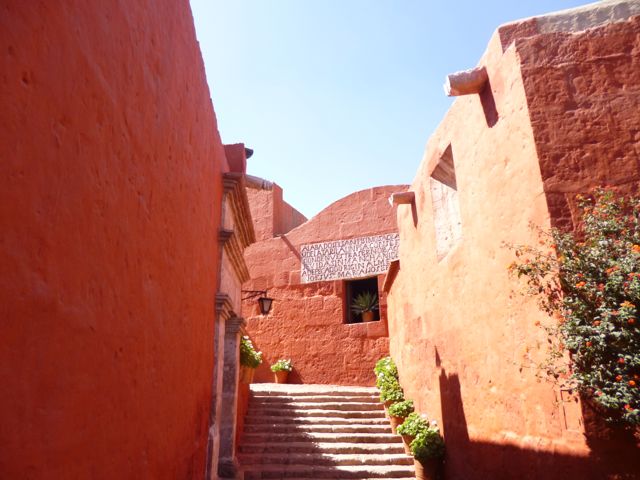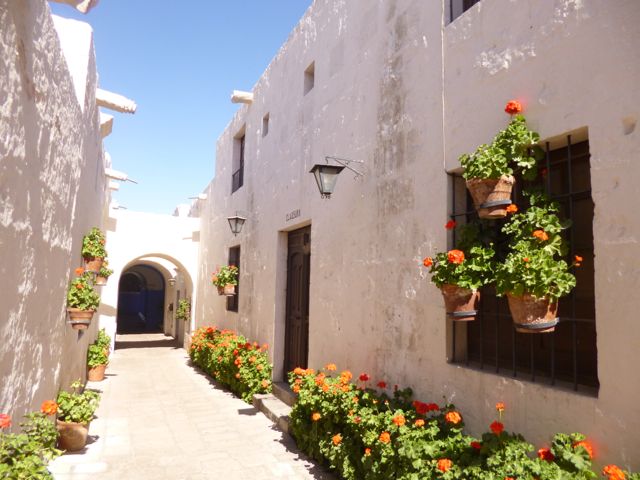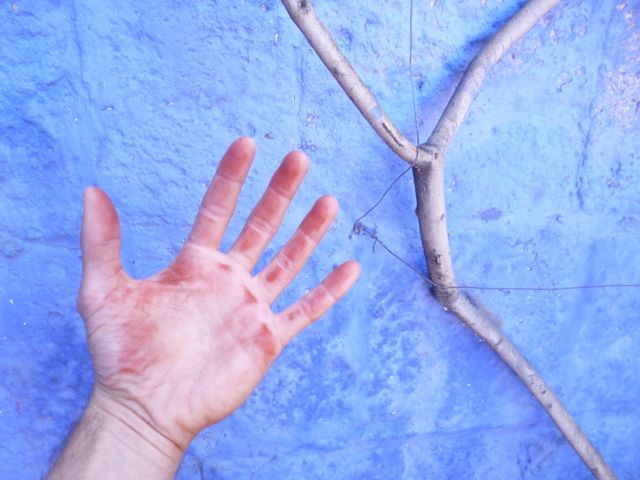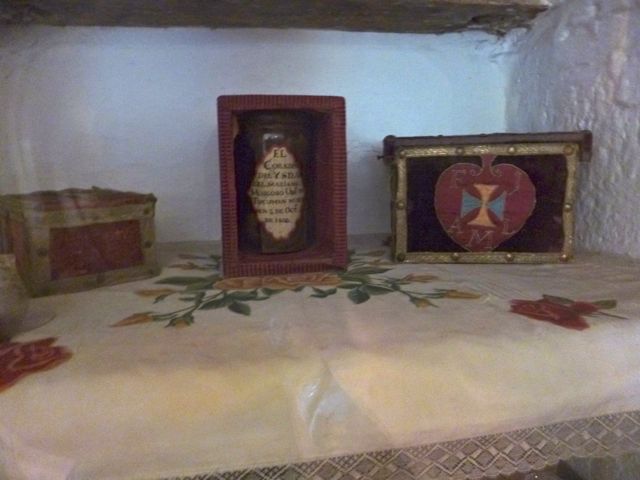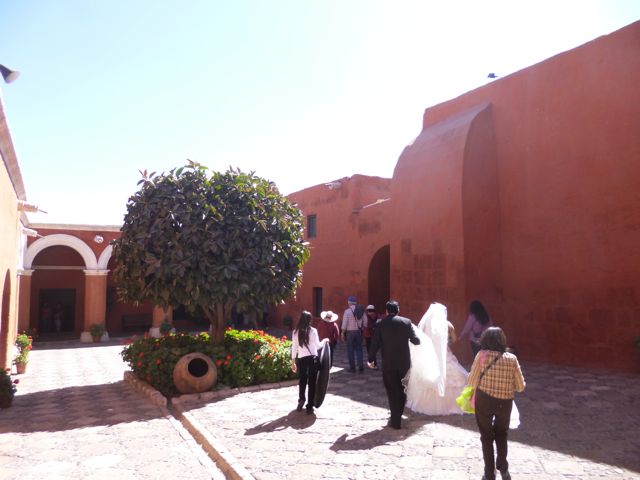Today, sticking to my goal of enjoying a simple, relaxed couple of days in lovely Arequipa, I did exactly two activities: Toured a monastery and studied Spanish.
Of course, the monastery I saw today, El Monasterio de Santa Catalina, happens to be one of the largest in the world, covering five acres and behaving for all the world like a city unto itself, complete with squares, named streets and gardens. It’s a Dominican order founded in 1579, and at its peak, in the 18th and 19th centuries, as many as 400 cloistered nuns lived here. Today, there are about 20 left, including a couple of novitiates. They live behind the walls of one of the community’s dozens of brightly painted buildings, hidden from the hundreds of tourists who visit the grounds each day. (Admission: S/30, or about $11.)
The place is entirely walled off from the rest of the city:
Like all of Arequipa, Santa Catalina has suffered considerably from earthquakes, sometimes accompanied by volcanic eruptions. That’s part of why so much of the city (including all of the monastery) is built of sillar: It’s so thick and sturdy. Sillar is a type of volcanic tuff — just like the stone from which the moai were carved. The city protected itself, in other words, by building itself of the product of the very seismic activity that so threatened it. There’s something poetic about that.
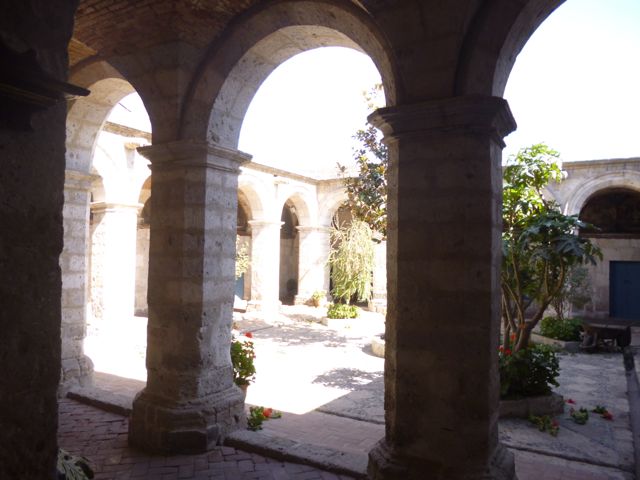
As I wandered through the mazelike grounds, I could imagine the stark but beautifully secluded lives of the nuns. Everywhere, there were truncated stairways in tiny rooms. These led to a second floor that no longer exists because of earthquake damage. Still, a wonderfully evocative image: Stairways to nowhere. Or ARE they really to nowhere?? (Dun dun DUNNN…)
In the first few hundred years of its existence, this was a highly desirable place for women to live. It cost a lot: The families of the nuns had to put up a dowry (about $150,000 in today’s money) that covered her living expenses and maintenance of the community. Therefore, many of the nuns came from very wealthy families. These were the nuns of the so-called Black Veil. There was also a lower social class, nuns of the White Veil, who acted as servants. They weren’t allowed to vote on matters affecting the monastery. Here’s a white-veiled nun’s costume, like a ghost in the corner:
The place still has a distinct air of gentility about it — all the flowers and frescoes and graceful-yet-folksy architecture:
Here’s the spooky room where visiting hours were held for dead nuns. Each one had her portrait painted after death, so there are lines of closed-eye portraits (the richest nuns, one suspects) on all the walls:
Here’s where the current 20 nuns live. I listened and watched for any sign of life from this building, but there was none:
At one point, I noticed that my hand was covered in the red paint that covers so many of the buildings. I must have dragged it along one or several of them. It’s hard not to want to touch this stone. It’s so roughly inviting.
The kitchen still smelled like ash from centuries-old fires. The chimney holes shone eyeballs of light onto the sooty walls.
One especially important 17th century nun, Ana de los Angeles Monteagudo, was named a saint in 1985. In her room are relics of bishops and other church luminaries. Among these are a couple of hearts and a liver. Mmmmmmm.
One long room, the pinoteca, displays hundreds of religious paintings that were “discovered,” according to the informational plaque, during restoration work on the monastery. I wondered where so many paintings could have been hiding so long?
A bride and groom rushed past, after having their photos taken:
I’ve decided to study Spanish in the afternoons during my time in Arequipa. I found a couple of tutors who work out of a local cafe, Cafe Connection, that donates its profits to a Christian missionary group working to help poor Peruanas. (Boy, I’m acting real Christian today, aren’t I?) Place also serves excellent espresso, with fair-trade beans grown in Puno.
For the next three days, I’ll be spending four hours working on mi espanol — two with an older guy named Alfredo and two with a younger woman named Ceclia, both native Arequipenas. (I’m paying them S/25 an hour, or $9. That sounds awfully low, I know, but they both appear to be middle/upper-middle class, so I’m gathering that $9 an hour is enough to live comfortably in this inexpensive city.) On our last day together, we’ll be eating lunch together (lunch, as in Chile, is the main meal) — so I hope to have lots of gratuitous food photos to share after that.
When we first met, Cecilia wanted to know where I was from. I told her I was American, and she looked at me, astonished.
“But most Americans speak really loud,” she said in Spanish. “And you don’t look American. Your skin and face.”
She thought for a moment. “You look… Belgian.”
I laughed. “Really? Oh, that’s interesting. OK.” Belgian? I’d take Belgian. I’ve only met a few Belgians in my life, but they’ve all been smart and interesting. But then maybe she’d say that to any new American student who told her he was a writer.
She also told me I spoke very slowly and correctly.
“Yeah. Sometimes I’d like to be less concerned about making mistakes.”
She shrugged. “It’s just the way you’re learning.”
I ate dinner at Lakshmi Van, one of the surprisingly large number of vegetarian restaurants in Arequipa. The place has been around some 30 years — long enough to still have a Geocities page. I was the only one in the whole place. That lunch fixation again, I guess. I ordered the vegetarian rocoto relleno, Arequipa’s most famous native dish, a hot pepper usually stuffed with steak, along with olives, cheese, ground peanuts and spicy secret sauce, served alongside cheesy sliced potatoes. This version had seitan instead of meat, and it was still delicious. Almost more enjoyable was the ensalada mixta, which came with vegetables I haven’t seen since I left the States: broccoli, green beans, spinach, lettuce. Together with a cup of red wine and tip, the tab came to about $13 — expensive by Arequipena standards.
Why don’t more Americans know about this city??? It’s beautiful, delicious, and cheap as heck! Oh wait, forget I said that. Let’s keep it a secret.












